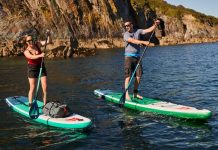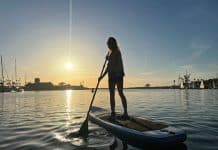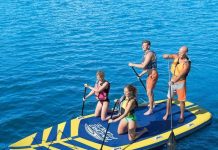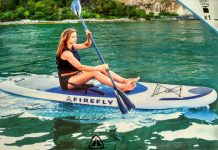Ah, the great outdoors! There’s something about the tranquil waters, the gentle breeze, and the sense of adventure that draws us to the art of canoeing. Whether you’re a seasoned paddler or a complete novice, this article is here to help you get started on your canoeing journey. From choosing the right paddle to mastering the art of steering, we’ve got you covered. So grab your life jacket and let’s embark on a paddling adventure together!
Choosing the Right Canoe
When it comes to canoeing, one of the most important decisions you’ll have to make is choosing the right canoe. The size of the canoe will largely depend on your needs and the number of people that will be paddling. A larger canoe is ideal if you plan on canoeing with a group or carrying a lot of gear, while a smaller canoe is perfect for solo adventures or shorter trips. Consider the weight capacity of the canoe as well, as you don’t want to overload it and compromise safety.
Considerations for Canoe Size
When selecting a canoe, think about your specific needs and the type of canoeing you plan on doing. If you’ll be embarking on long trips or camping excursions, a larger canoe with ample storage space would be beneficial. On the other hand, if you’re mainly interested in recreational paddling or exploring calm lakes and rivers, a smaller canoe might be more maneuverable and easier to handle.
Types of Canoes
There are several types of canoes available, each with its own unique characteristics. Traditional canoes, often made of wood or fiberglass, are ideal for recreational canoeing. They offer stability and are generally easy to paddle. Another popular choice is the inflatable canoe, which is lightweight and easy to transport. These can be a great option if you’re limited on storage space or plan on traveling to different destinations for your canoeing adventures.
Selecting Appropriate Paddles
Choosing the right paddles is just as important as selecting the right canoe. Paddles are available in various lengths and materials, and it’s crucial to consider factors such as your height, paddling style, and the type of water you’ll be canoeing on.
Determining Paddle Length
The length of your paddle is determined by a combination of your height and the width of your canoe. Generally, taller individuals will require longer paddles to ensure proper reach and efficiency. For solo paddling, a shorter paddle may be more suitable, while tandem paddling often calls for longer paddles to accommodate the wider canoe.
Paddle Material Options
Paddles come in different materials, each with its own pros and cons. Wooden paddles are classic and offer a traditional feel, but they can be heavy and require occasional maintenance. Aluminum paddles are affordable and lightweight, but they may not be as durable as other materials. Fiberglass and carbon fiber paddles are lightweight and provide excellent performance, but they tend to be more expensive. Consider your budget and paddling needs when selecting the material for your paddles.
Essential Safety Gear for Canoeing
Safety should always be your top priority when canoeing. Having the right safety gear can make a huge difference in ensuring a safe and enjoyable experience on the water.
Personal Flotation Devices (PFDs)
One essential piece of safety gear that should never be overlooked is a personal flotation device (PFD). PFDs, also known as life jackets, come in various styles, including inflatable options and ones specifically designed for canoeing. Choose a PFD that fits properly and meets all safety regulations. It’s important to wear your PFD at all times while on the water, even if you are a strong swimmer.
Safety Whistle and Signal Mirror
In addition to a PFD, it’s also a good idea to carry a safety whistle and a signal mirror. A safety whistle is a simple device that can be used to alert others in case of an emergency or to communicate with fellow paddlers. A signal mirror, on the other hand, can be used to attract attention or signal for help in case of an emergency. These small yet effective tools can make a significant difference during unforeseen situations.
Mastering Proper Paddling Techniques
To truly enjoy canoeing to its fullest, it’s important to master proper paddling techniques. This will not only make your strokes more efficient but also make maneuvering the canoe much easier.
Grip and Hand Placement
The grip and hand placement on your paddle can greatly affect your overall paddling experience. Start by holding the paddle with both hands about shoulder-width apart. Keep a relaxed grip, and make sure your knuckles are aligned with the paddle blade. This will provide optimal control and power during your strokes.
Basic Strokes – Forward Paddle, Backward Paddle, and Draw Stroke
The forward paddle stroke is the most basic and fundamental stroke in canoeing. Start by reaching forward with your paddle, fully submerge it into the water, and pull it back towards your hip. The backward paddle stroke is similar, but instead of pulling the paddle towards your hip, you push it away from your hip. The draw stroke is useful for moving the canoe sideways or towards an object. To execute a draw stroke, start with your paddle resting against the side of the canoe, then pull it towards you while keeping it parallel to the side of the canoe.
Understanding Canoe Maneuvering
Canoe maneuvering is all about being able to control the direction and movement of the canoe with ease. There are several techniques that can help you achieve this, including the J-stroke, sweep stroke, and pivot turn.
J-Stroke
The J-stroke is a maneuver that helps maintain a straight line while paddling on one side of the canoe. It involves a combination of a forward stroke and a corrective stroke. As you start the forward stroke on one side, twist your wrist to turn the paddle blade slightly outwards. At the end of the stroke, move the paddle slightly away from the canoe and perform a small reverse stroke or a pry stroke. This will correct the canoe’s tendency to turn towards the opposite side.
Sweep Stroke
The sweep stroke is employed when you need to turn the canoe. Begin by fully submerging your paddle in the water towards the front of the canoe. Sweep the paddle outward in a wide arc, keeping it in contact with the water throughout. This stroke creates a pivot point around which the canoe will turn.
Pivot Turn
The pivot turn is a more advanced maneuver used to quickly change the direction of the canoe. To perform a pivot turn, paddle forward on one side, then lean towards the opposite side while leaning your weight onto the paddle on that side. This will cause the canoe to turn rapidly in the direction of your paddle.
Navigating Different Water Conditions
Canoeing can take place in a variety of water conditions, each requiring different techniques and skills. Understanding the different types of water conditions will help you navigate safely and effectively.
Flatwater Canoeing
Flatwater canoeing refers to paddling on calm bodies of water such as lakes, ponds, or slow-moving rivers. This type of canoeing is often preferred by beginners and recreational paddlers. The calm conditions allow for easier paddling and smoother maneuvering. In flatwater canoeing, it’s important to maintain a proper technique to maximize efficiency and minimize fatigue.
River Canoeing
River canoeing involves paddling on moving water, which adds an exciting element to your canoeing adventures. Navigating rivers requires additional skills and the ability to read the water, anticipate obstacles, and use the current to your advantage. It’s important to choose a river with a suitable difficulty level for your skill and experience level.
Whitewater Canoeing
Whitewater canoeing is an exhilarating and challenging form of canoeing that involves paddling on fast-moving, turbulent water. This type of canoeing requires specialized skills and equipment. Before attempting whitewater canoeing, it’s crucial to receive proper training and gain experience in lesser challenging rapids.
Dealing with Canoeing Hazards
While canoeing is an enjoyable and peaceful activity, it’s important to be aware of potential hazards that can arise on the water. By being prepared and knowing how to handle these situations, you can ensure a safe and memorable canoeing experience.
Submerged Obstacles
Submerged obstacles such as rocks, tree trunks, or debris can pose a threat to canoeists. It’s crucial to scan the water ahead and steer clear of any potential obstacles. If you do encounter an obstacle, stay calm and try to navigate around it safely. Sometimes, portaging or carrying the canoe around the obstacle may be the safest option.
Strainers
Strainers are areas in the water that allow water to pass through but can trap or pin a canoe or paddler. They are typically formed by fallen trees or other vegetation that creates a tight mesh. Avoid paddling near or under strainers as they can be extremely dangerous. Always be mindful of your surroundings and choose safe routes to paddle.
Capsizing and Swamping Situations
Capsizing or swamping is always a possibility when canoeing, especially in challenging water conditions. The most important thing in these situations is to stay calm and remember your training. If you find yourself capsized or swamped, try to stay with the canoe and use it for support. Practice self-rescue techniques, such as the “flip and drain” method, to quickly get back into your canoe.
Proper Canoe Carrying and Launching
Properly carrying and launching a canoe is essential for a smooth and safe start to your paddling journey. Following the right techniques will help prevent injuries and ensure a successful launch.
Canoe Carrying Techniques
When carrying a canoe, it’s important to distribute the weight evenly to avoid straining your back or neck. One common carrying technique is the “Canadian grip,” where one person holds the canoe at the center, with one hand on each side. Another option is to use a yoke, which is a specialized carrying device that rests on your shoulders. Whichever technique you choose, make sure to practice it beforehand and always ask for assistance if needed.
Efficient Launching Strategies
Launching a canoe can be a bit challenging, especially if you’re doing it alone or if the shoreline is rocky or steep. To launch your canoe efficiently, start by placing the canoe parallel to the water’s edge. If the shoreline is slippery, consider using a non-slip mat or launching directly from a dock. Slowly push the canoe into the water until it’s afloat and then carefully step in, making sure to maintain your balance.
Planning for Canoe Camping Trips
Canoe camping trips provide the opportunity for unique and immersive outdoor experiences. To ensure a successful and enjoyable trip, it’s essential to plan ahead and pack the necessary gear.
Essential Camping Gear
When preparing for a canoe camping trip, packing the right gear is crucial. Some essential items include a tent, sleeping bags, cooking equipment, food, water, a portable stove, camping chairs, and a first-aid kit. It’s important to pack lightweight and compact gear, as space is limited in a canoe.
Packing and Loading Canoe for a Trip
Properly packing and loading your canoe is essential for a balanced and stable journey. Distribute the weight evenly and keep heavier items closer to the center of the canoe to maintain its stability. Utilize dry bags or waterproof containers to protect your gear from water damage. Take your time when loading the canoe, making sure everything is securely fastened, and do a final weight and balance check before setting off on your adventure.
Building Canoeing Skills and Experience
To become a skilled and confident canoeist, it’s beneficial to seek out opportunities for learning and gaining experience.
Attending Canoeing Courses
Enrolling in canoeing courses can provide valuable knowledge and improve your abilities on the water. Look for local paddling schools or outdoor recreation centers that offer beginner or advanced canoeing courses. These courses often cover a range of topics, including paddling technique, safety skills, and maneuvering in different water conditions.
Joining Canoeing Clubs or Groups
Joining canoeing clubs or groups is a great way to meet fellow enthusiasts and gain practical experience. These communities often organize canoe trips, events, and workshops, providing opportunities to paddle with experienced individuals and learn from their expertise. Being part of a community of like-minded individuals can enhance your enjoyment of canoeing and provide a supportive network.
By taking the time to consider the right canoe, master proper paddling techniques, understand canoe maneuvering, and equip yourself with essential safety gear, you’ll be well on your way to enjoying the wonders of canoeing. With practice and experience, you can explore different water conditions, navigate hazards, and even embark on exciting canoe camping trips. So get out on the water, paddle with confidence, and create lasting memories in your canoeing adventures!





































